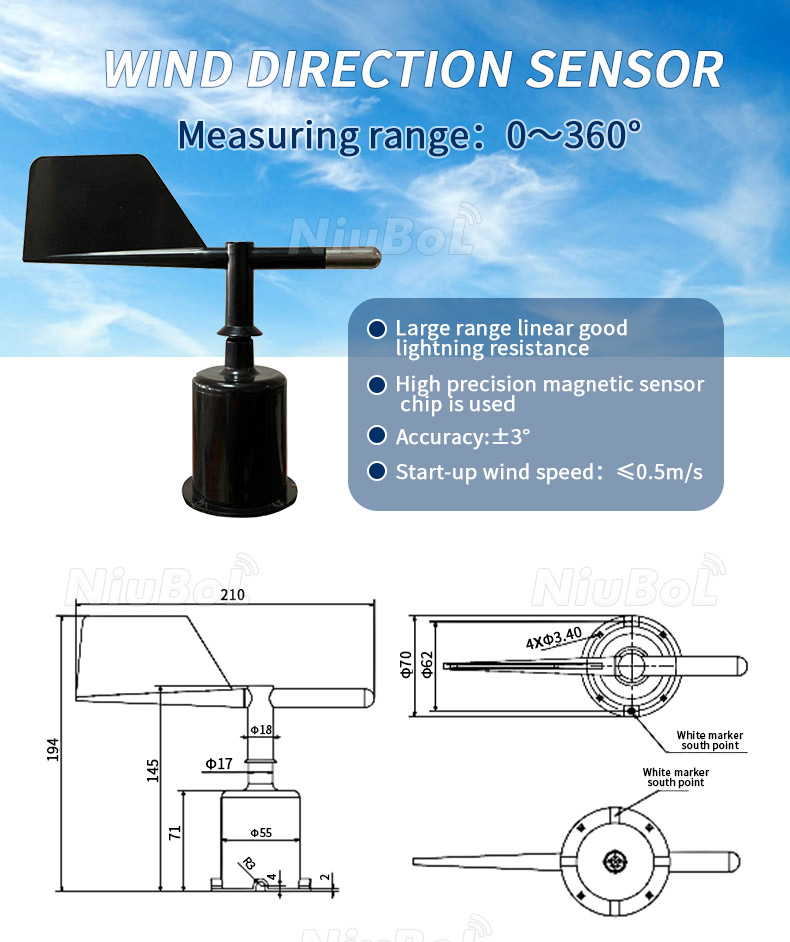

— Blogs —
—Products—
 Consumer hotline +8618073152920
Consumer hotline +8618073152920 WhatsApp:+8615367865107
Address:Room 102, District D, Houhu Industrial Park, Yuelu District, Changsha City, Hunan Province, China
Product knowledge
Time:2024-07-14 16:04:22 Popularity:430
Mechanical Anemometers and Ultrasonic Anemometers are two common types of wind speed measurement devices that have some significant differences in their operating principles and applications:
Wind Sensor Structure and Principle of Operation
Mechanical Wind Sensor
Structure: mechanical wind sensors are usually divided into two parts, wind speed sensor and wind direction sensor, not an integrated design. The wind speed sensor often adopts the wind cup structure, such as three-cup or four-cup rotating frame structure, through the rotation of the wind cup to measure the wind speed. The wind direction sensor adopts the mechanical structure of the wind vane, and detects the wind direction through the rotation of the wind vane.
Working Principle: The wind speed sensor uses the rotation of the wind cup to linearly convert the wind speed into the rotational speed of the rotating frame, and then converts the rotational speed into an electrical signal for output through photoelectric switches and other devices. The wind direction sensor, on the other hand, transmits the wind direction information to the coaxial code disc and other devices through the rotation of the wind vane, and outputs the corresponding wind direction value.
Ultrasonic Wind Sensor
Structure: An ultrasonic wind sensor is an all-in-one device that uses the principle of ultrasonic waves to measure both wind speed and wind direction. It usually contains a transmitter and a receiver, and calculates wind speed and direction by transmitting ultrasonic waves and measuring their propagation time or frequency change.
Working Principle: Ultrasonic wind sensors use the ultrasonic time difference method to achieve the measurement of wind speed and direction. When ultrasonic waves propagate in the air, their speed is affected by the wind. If the propagation direction of ultrasonic waves is the same as the wind direction, the speed will be accelerated; conversely, if the direction is opposite, the speed will be slowed down. By measuring the difference in time between the propagation of ultrasound waves in the downwind and upwind directions, the wind speed and direction can be calculated. This sensor requires no moving parts and is therefore a non-contact, no mechanical loss measurement method.
Advantages and disadvantages of mechanical wind sensors and ultrasonic wind sensors
Mechanical wind sensor
Advantages: relatively simple structure, low cost, easy to maintain and replace.
Mechanical wind sensors: usually higher accuracy, especially stable performance at higher wind speeds.
Disadvantages: the presence of rotating parts, requires a certain start-up wind speed for measurement, and the measurement accuracy is greatly affected by the mechanical structure. In addition, mechanical parts may wear out in long-term use, affecting measurement accuracy and life.
Ultrasonic wind sensor
Advantages: no need for rotating parts, high measurement accuracy, fast response speed, and the ability to simultaneously measure the instantaneous value of wind speed and wind direction. And is not affected by temperature, humidity and other environmental factors, good stability.
Ultrasonic wind sensor : good sensitivity, can measure wind speed as low as the breeze, and is not affected by mechanical wear and tear
Disadvantages: relatively high cost and high requirements for ultrasonic transmission and reception devices.

Wind sensor application scenarios
Mechanical wind sensor: suitable for occasions where the requirements for measurement accuracy are not particularly high and the cost is limited, such as general meteorological observation stations, agricultural meteorological monitoring.
ultrasonic wind sensor: more suitable for occasions with higher requirements for measurement accuracy and response speed, such as weather forecasting, wind power generation, aerospace and other fields.
In summary, mechanical wind sensors and ultrasonic wind sensors have significant differences in structure, working principle, advantages and disadvantages, as well as application scenarios. Which sensor to choose needs to be determined according to the specific measurement needs and scenarios.
Related recommendations
Sensors & Weather Stations Catalog
Agriculture Sensors and Weather Stations Catalog-NiuBoL.pdf
Weather Stations Catalog-NiuBoL.pdf
Related products
 Combined air temperature and relative humidity sensor
Combined air temperature and relative humidity sensor Soil Moisture Temperature sensor for irrigation
Soil Moisture Temperature sensor for irrigation Soil pH sensor RS485 soil Testing instrument soil ph meter for agriculture
Soil pH sensor RS485 soil Testing instrument soil ph meter for agriculture Wind Speed sensor Output Modbus/RS485/Analog/0-5V/4-20mA
Wind Speed sensor Output Modbus/RS485/Analog/0-5V/4-20mA Tipping bucket rain gauge for weather monitoring auto rainfall sensor RS485/Outdoor/stainless steel
Tipping bucket rain gauge for weather monitoring auto rainfall sensor RS485/Outdoor/stainless steel Pyranometer Solar Radiation Sensor 4-20mA/RS485
Pyranometer Solar Radiation Sensor 4-20mA/RS485
Screenshot, WhatsApp to identify the QR code
WhatsApp number:+8615367865107
(Click on WhatsApp to copy and add friends)